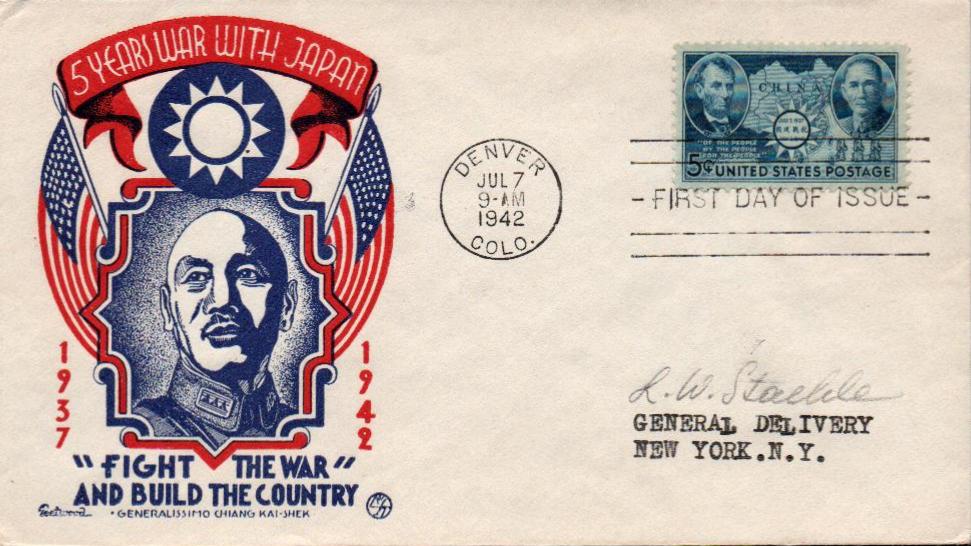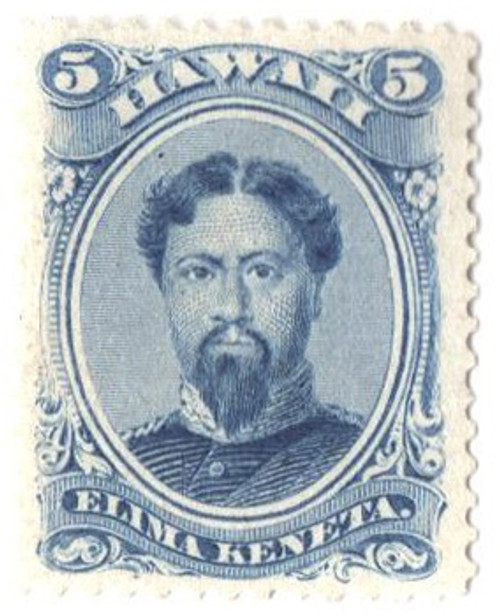
# H40 - 1882 10c Hawaii, black, perf 12, wove paper
Kingdom of Hawaii Stamp
Features Hawaii’s “Merrie Ruler”
Own the 1882 Hawaii stamp honoring King Kalakaua, known as the “Merrie Ruler” for his extravagant lifestyle. Once a postmaster in the kingdom, King Kalakaua revived hula, which missionaries had previously banned.
This striking stamp is a direct connection to this romantic period of Hawaiian history. As an independent kingdom that became a state, Hawaii stamps are perfect for U.S. collectors looking to expand their interests. Get this remarkably affordable mint stamp right away.
Birth Of Chinese Revolutionary Sun Yat-Sen
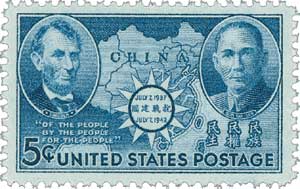
Sun Yat-Sen was born on November 12, 1866, in Xiangshan County, Guangdong, China. He was known by a number of names during his life – Sun Wen, Sun Deming, and Sūn Zhōngshān, but he is most famously known by the name he used at school in Hong Kong, Sun Yat-Sen.
Sun attended school in China until he was 13, at which point he went to live with his older brother in Honolulu, Hawaii. There he attended the ‘Iolani School and studied English, British history, math, science, and Christianity. He reportedly learned English so quickly he received a special prize for outstanding achievement from King David Kalākaua.
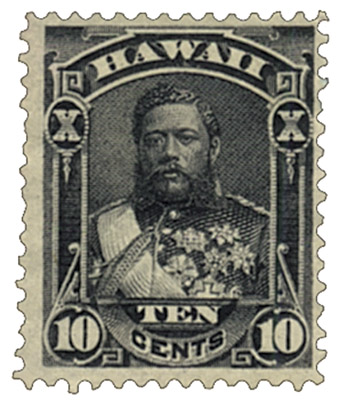
Sun attended Oahu College for one semester, but was sent back to China out of his brother’s fear that he might convert to Christianity. Upon returning to China, Sun and a friend grew concerned watching people worship the Beiji Emperor-God and were dissatisfied with their ancient healing methods. In an act of defiance they broke the god’s statue, upsetting the villagers, and leading them to flee to Hong Kong.
In Hong Kong, Sun continued his education and studied medicine, eventually earning a medical license. It was also here that he was baptized into Christianity. Living in Hong Kong Sun also befriended the Four Bandits, a group of revolutionary thinkers. Sun grew disillusioned with the Qing government for its refusal to accept knowledge from the more technologically advanced Western nations. He opted to abandon his medical practice and devote his time to improving China.
In 1891 Sun join a revolutionary group that wanted to overthrow the Qing. He wrote a petition on modernizing China but wasn’t allowed an audience with the viceroy. So he left China for Hawaii, where he founded the Revive China Society. In 1895 the group planned the First Guangzhou uprising. But the plans were leaked and the Qing government captured many members.
Though he wasn’t captured, Sun escaped to Japan in exile. He gained Japanese support for his movement and also joined in the Philippine Revolution. Sun then planned another uprising, an attack on Huizhou, but it also failed. After that he traveled to Japan, Europe, the U.S., and Canada to raise money and support for his revolutionary party.
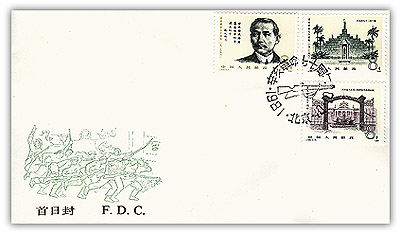
By the turn of the 20th century, Sun narrowed his goals. He wanted to “expel the Tartar barbarians (Manchu), to revive Zhonghua, to establish a Republic, and to distribute land equally among the people.” He also developed his Three Principles of the People, which were nationalism, democracy, and welfare.
Sun grew his revolution in Japan and Malaya among Chinese students and residents. In 1907 and 1908 Sun staged several more failed uprising, leading some of his followers to turn against him. But he still had a strong following and continued to raise money and support. However, on October 10, 1911, another revolutionary leader, Huang Xing, led a successful uprising that ultimately led to the fall of the Qing Empire. Sun was credited for funding the revolution, keeping its spirit alive, and merging the smaller revolutionary groups into a larger force capable of this uprising.
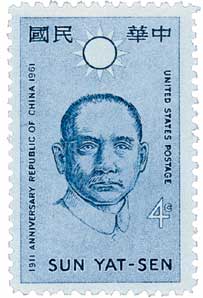
Sun immediately returned to China and was elected the provisional president on December 29, 1911. His term was short-lived and a new provisional president was selected in March 1912. But Sun continued to work encouraging provincial leaders to establish a National Assembly of the Republic of China.
China was in a state of unrest in the coming years. There was a second revolution, political assassinations, and political chaos. China became divided between different military leaders and no proper central government. Sun encouraged Chinese reunification and started his own government in Guangzhou, of which he was elected Grand Marshal. Sun soon decided that the best course of action was to cooperate with Communist Party of China. Working with the Soviets, he led a military expedition against northern China.
Sun spent the next few years traveling and delivering speeches on his beliefs and encouraging national reunification. However, he died of liver cancer on March 12, 1925. Following his death, his followers engaged in a power struggle that divided them. China then fell into Civil War, ultimately resulting in the communist People’s Republic of China.
For his work to modernize China, Sun has been called the “Father of the Nation” of the Republic of China. He is unique in Chinese history, as he is revered by both communist China and Taiwan.
U.S. #906 was issued to commemorate the fifth anniversary of China’s resistance against the Japanese Empire in the early days of World War II. The stamp pictures Sun and Abraham Lincoln. Sun’s Three Principles (nationalism, democracy, and people’s livelihood) were inspired by the last portion of Lincoln’s Gettysburg address, “Of the people, by the people, for the people.” Both inscriptions are written under the respective statesman, Sun Yat-sen’s in Chinese characters.
A map of China and the Republic’s national symbol, a sun, are also pictured on the stamp. In addition, the date of the beginning of the war and the Chinese motto “Fight the War and Build the Country” are inscribed in the sun.
The stamp was issued in Denver, Colorado, because Sun Yat-Sen was visiting that city in 1911, when he received word China was free from the Qing Empire. That’s when he returned to China to become the president.
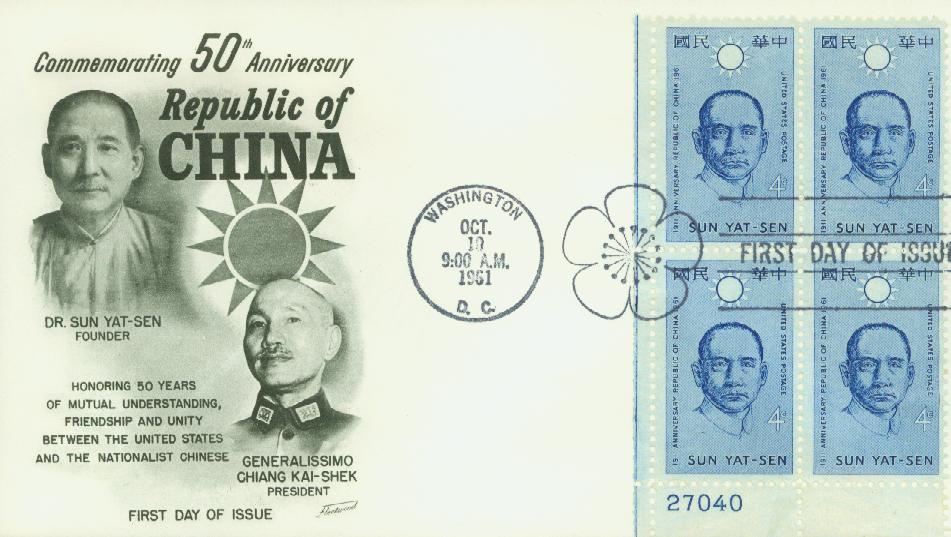
U.S. #1188 was issued to commemorate the 50th anniversary of China’s revolt against the Qing Empire. President Kennedy pushed for a stamp picturing Sun Yat-Sen to soften tensions between the U.S. and the Republic of China (in Taiwan). Originally, the wording on the stamp going to be “50th Anniversary of the Chinese Revolution,” but the Chinese in Taiwan opposed it because it could be associated with the Communist revolution in mainland China that took place in 1949. The inscription was changed to “1911 Anniversary Republic of China 1961.” The Chinese characters across the top of the stamp spell out the Republic of China.
Issued during the Cold War, the Post Office Department received many complaints from citizens who thought the stamp supported Communism. In a letter created to address the complaints, the Post Office stated the stamp was issued as “a gesture of friendship toward free China” and Sun Yat-Sen “symbolized freedom and democracy.” It would be another decade before the U.S. would begin diplomatic relations with Communist China.
Click here and here for a pair of recent Linn’s articles about the surge in popularity of both of these U.S. stamps.
Kingdom of Hawaii Stamp
Features Hawaii’s “Merrie Ruler”
Own the 1882 Hawaii stamp honoring King Kalakaua, known as the “Merrie Ruler” for his extravagant lifestyle. Once a postmaster in the kingdom, King Kalakaua revived hula, which missionaries had previously banned.
This striking stamp is a direct connection to this romantic period of Hawaiian history. As an independent kingdom that became a state, Hawaii stamps are perfect for U.S. collectors looking to expand their interests. Get this remarkably affordable mint stamp right away.
Birth Of Chinese Revolutionary Sun Yat-Sen

Sun Yat-Sen was born on November 12, 1866, in Xiangshan County, Guangdong, China. He was known by a number of names during his life – Sun Wen, Sun Deming, and Sūn Zhōngshān, but he is most famously known by the name he used at school in Hong Kong, Sun Yat-Sen.
Sun attended school in China until he was 13, at which point he went to live with his older brother in Honolulu, Hawaii. There he attended the ‘Iolani School and studied English, British history, math, science, and Christianity. He reportedly learned English so quickly he received a special prize for outstanding achievement from King David Kalākaua.

Sun attended Oahu College for one semester, but was sent back to China out of his brother’s fear that he might convert to Christianity. Upon returning to China, Sun and a friend grew concerned watching people worship the Beiji Emperor-God and were dissatisfied with their ancient healing methods. In an act of defiance they broke the god’s statue, upsetting the villagers, and leading them to flee to Hong Kong.
In Hong Kong, Sun continued his education and studied medicine, eventually earning a medical license. It was also here that he was baptized into Christianity. Living in Hong Kong Sun also befriended the Four Bandits, a group of revolutionary thinkers. Sun grew disillusioned with the Qing government for its refusal to accept knowledge from the more technologically advanced Western nations. He opted to abandon his medical practice and devote his time to improving China.
In 1891 Sun join a revolutionary group that wanted to overthrow the Qing. He wrote a petition on modernizing China but wasn’t allowed an audience with the viceroy. So he left China for Hawaii, where he founded the Revive China Society. In 1895 the group planned the First Guangzhou uprising. But the plans were leaked and the Qing government captured many members.
Though he wasn’t captured, Sun escaped to Japan in exile. He gained Japanese support for his movement and also joined in the Philippine Revolution. Sun then planned another uprising, an attack on Huizhou, but it also failed. After that he traveled to Japan, Europe, the U.S., and Canada to raise money and support for his revolutionary party.

By the turn of the 20th century, Sun narrowed his goals. He wanted to “expel the Tartar barbarians (Manchu), to revive Zhonghua, to establish a Republic, and to distribute land equally among the people.” He also developed his Three Principles of the People, which were nationalism, democracy, and welfare.
Sun grew his revolution in Japan and Malaya among Chinese students and residents. In 1907 and 1908 Sun staged several more failed uprising, leading some of his followers to turn against him. But he still had a strong following and continued to raise money and support. However, on October 10, 1911, another revolutionary leader, Huang Xing, led a successful uprising that ultimately led to the fall of the Qing Empire. Sun was credited for funding the revolution, keeping its spirit alive, and merging the smaller revolutionary groups into a larger force capable of this uprising.

Sun immediately returned to China and was elected the provisional president on December 29, 1911. His term was short-lived and a new provisional president was selected in March 1912. But Sun continued to work encouraging provincial leaders to establish a National Assembly of the Republic of China.
China was in a state of unrest in the coming years. There was a second revolution, political assassinations, and political chaos. China became divided between different military leaders and no proper central government. Sun encouraged Chinese reunification and started his own government in Guangzhou, of which he was elected Grand Marshal. Sun soon decided that the best course of action was to cooperate with Communist Party of China. Working with the Soviets, he led a military expedition against northern China.
Sun spent the next few years traveling and delivering speeches on his beliefs and encouraging national reunification. However, he died of liver cancer on March 12, 1925. Following his death, his followers engaged in a power struggle that divided them. China then fell into Civil War, ultimately resulting in the communist People’s Republic of China.
For his work to modernize China, Sun has been called the “Father of the Nation” of the Republic of China. He is unique in Chinese history, as he is revered by both communist China and Taiwan.
U.S. #906 was issued to commemorate the fifth anniversary of China’s resistance against the Japanese Empire in the early days of World War II. The stamp pictures Sun and Abraham Lincoln. Sun’s Three Principles (nationalism, democracy, and people’s livelihood) were inspired by the last portion of Lincoln’s Gettysburg address, “Of the people, by the people, for the people.” Both inscriptions are written under the respective statesman, Sun Yat-sen’s in Chinese characters.
A map of China and the Republic’s national symbol, a sun, are also pictured on the stamp. In addition, the date of the beginning of the war and the Chinese motto “Fight the War and Build the Country” are inscribed in the sun.
The stamp was issued in Denver, Colorado, because Sun Yat-Sen was visiting that city in 1911, when he received word China was free from the Qing Empire. That’s when he returned to China to become the president.

U.S. #1188 was issued to commemorate the 50th anniversary of China’s revolt against the Qing Empire. President Kennedy pushed for a stamp picturing Sun Yat-Sen to soften tensions between the U.S. and the Republic of China (in Taiwan). Originally, the wording on the stamp going to be “50th Anniversary of the Chinese Revolution,” but the Chinese in Taiwan opposed it because it could be associated with the Communist revolution in mainland China that took place in 1949. The inscription was changed to “1911 Anniversary Republic of China 1961.” The Chinese characters across the top of the stamp spell out the Republic of China.
Issued during the Cold War, the Post Office Department received many complaints from citizens who thought the stamp supported Communism. In a letter created to address the complaints, the Post Office stated the stamp was issued as “a gesture of friendship toward free China” and Sun Yat-Sen “symbolized freedom and democracy.” It would be another decade before the U.S. would begin diplomatic relations with Communist China.
Click here and here for a pair of recent Linn’s articles about the surge in popularity of both of these U.S. stamps.






